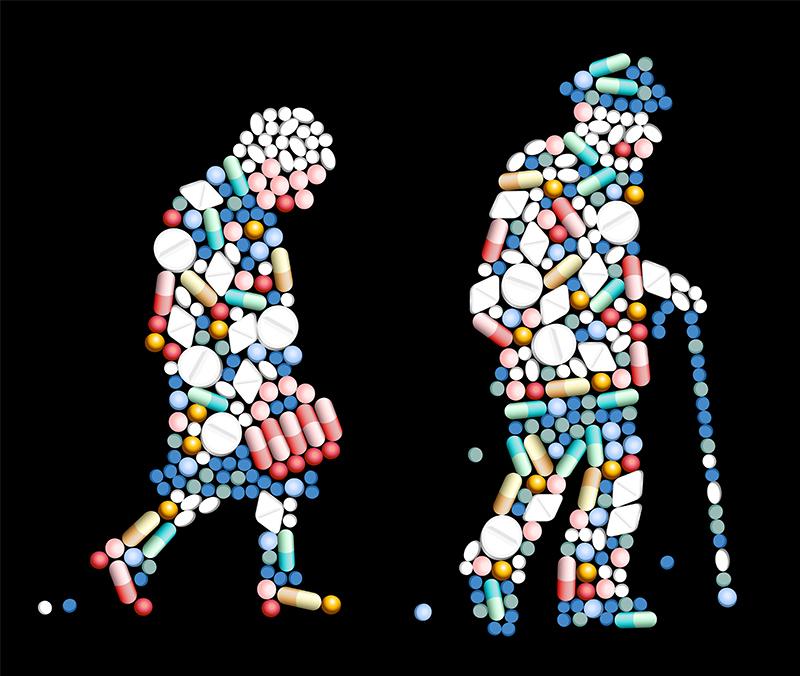Awful lot of pills: Deprescribing improves survival in older adults





Weaning older adults off unnecessary medications leads to a better outlook in terms hospitalizations and mortality, in addition to reducing pill burden, although it may not help much in preventing falls, according to a Singapore study.
“[W]e did not find a significant change in fall rates after 6 months. However, our study suggests that deprescribing-naïve [nursing home] residents may benefit from [the] intervention, as there was a reduction in fall risk among this group of individuals,” the investigators said.
Based on the Beers and STOPP criteria, the intervention used in the study was pharmacist-led and consisted of five steps. It started with identifying inappropriate drug use through a comprehensive medication history review. This was followed by the assessment of any drug–drug and drug–food interactions to reduce risks of adverse drug events.
The next three steps involved communication and documentation. Pharmacists conferred with nurses regarding the feasibility of deprescribing for each resident, with an option to discuss with the residents themselves or their family members. These nurses then relayed everything to physicians for planning and initiation of medication withdrawal. The last step entailed documentation, monitoring, and support.
In a randomized cohort of 295 residents from four nursing homes across Singapore, the deprescribing programme did not reduce the co-primary outcomes of falls rate and risk at 6 months as compared with an active waitlist control. However, in the subgroup of deprescribing-naïve participants, the intervention decreased the falls risk score by 0.18 (p=0.04), but not falls rate (p=0.44). [J Am Med Dir Assoc 2020;doi:10.1016/j.jamda.2020.03.012]
Deprescribing also resulted in lower mortality (hazard ratio [HR], 0.16, 95 percent CI, 0.07–0.41; p<0.001) and smaller number of hospitalized residents (HR, 0.16, 95 percent CI, 0.10–0.26; p<0.001).
Pre-post analysis revealed a substantial decrease in pill burden at the end of the study, which remained even a year later. Furthermore, deprescribing yielded a conservative daily cost saving estimate of US $11.42 (SG $15.65), corresponding to a modest annual saving of US $4,168.30 (SG $5,712.25) per resident for the healthcare system.
Overall, the physicians accepted about three-quarters of deprescribing interventions initiated by the pharmacists.
“We saw that the main type of drug-related problem is medication use without indication, and that gastrointestinal, anticholinergics, pain, and endocrine medications are the most frequently deprescribed medications,” according to the investigators, adding that gastrointestinal drug class was the most deprescribed category.
Such findings have important implications, given that proton-pump inhibitors have been associated with increased mortality risks, and that anticholinergics may induce drowsiness and factor in the development of dementia. [BMJ Open 2017;7:e015735; JAMA Intern Med 2015;175:401-407]
“[Finally], pain medication, such as morphine, and endocrine medications, such as hypoglycaemic agents, can cause drowsiness and dizziness, respectively. These adverse effects increase fall risks, which in turn contribute to hospitalization and death,” they said.
The investigators emphasized, however, that the results should be interpreted in light of several limitations. For the most part, the similarity in fall rates might be attributed to the waitlist control group lagging 3 months behind, which may be insufficient to observe any changes. Also, reducing pill burden and the number of medications proved challenging due to the frequent change in medications in the study population of frail older adults.
“Future studies looking at other clinical outcomes and different settings will be important to increase the evidence base of the effectiveness of such deprescribing practice. A competing risk approach is suggested for future studies where mortality is assessed as the primary outcome,” the investigators said.